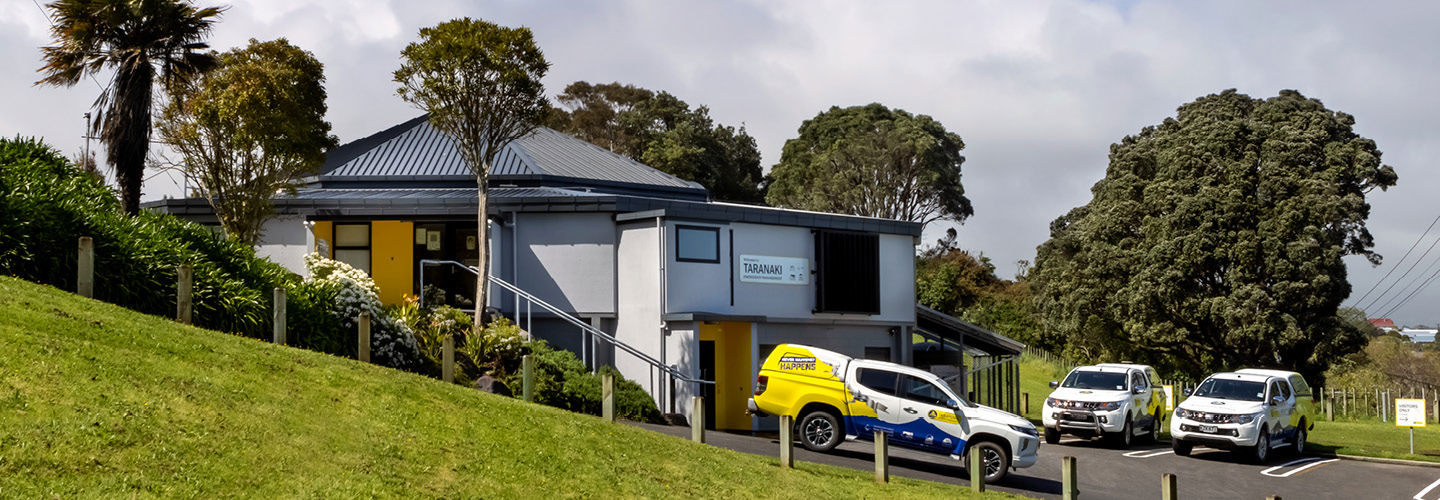Taranaki Emergency Management is a shared service between all four councils in Taranaki and works in partnership with emergency services and other organisations to ensure effective coordination of emergency management within its area.
Governance of the Taranaki Civil Defence Emergency Management Group (CDEM) is provided by Joint Committee (JC).
The Taranaki Emergency Civil Defence Emergency Management Group
Vision
Our Taranaki community shows resilience through periods of disaster, crisis and change.
Core Purpose
We deliver professional disaster risk and emergency management for Taranaki.
Core values
- Collective responsibility: Shared between National, Group and District level.
- Unified approach: Civil Defence Emergency Management (CDEM) partners work for the overall benefit of the Taranaki Community.
- Organisational resilience: Any part of the system can lend support seamlessly.
- Strong relationships: Strong effective coordination and integration.
The aim of Taranaki Emergency Management is:
- Understand Taranaki hazards, their likelihood and impacts.
- Build resilience into organisations and plan for the impacts from disaster and ensure our systems and arrangements are fit for purpose.
- Foster collaboration across the emergency management system to ensure a well management effective responses to support the community during a disaster.
- Assist our communities in becoming more resilient to hazards and prepared for emergencies.
- Taranaki Regional Council
- New Plymouth District Council
- South Taranaki District Council
- Stratford District Council
- NZ Police
- Fire and Emergency New Zealand
- Te Whatu Ora Taranaki
- St John Ambulance
- Ministry of Primary Industries
- Ministry of Social Development
- Ngā Iwi o Taranaki
Head to Governance, Strategies and Plans for an overview of which organisations are part of our Coordinating Executive Group (CEG).
Taranaki Emergency Management Office (TEMO)
The Taranaki Emergency Management Office works to coordinate and facilitate the day-to-day planning and project work on behalf of the Taranaki Civil Defence Emergency Management (CDEM) Group. TEMO is located at 45 Robe St, New Plymouth, and administered by Taranaki Regional Council (TRC) with services delivered by New Plymouth District Council (NPDC).
During an emergency response, TEMO will often activate the Emergency Coordination Centre (ECC) located at their office to assist with and manage the response at regional level.
Advisory Group
A key function of TEMO is to facilitate strong relationships and networks between organisations that may be involved in an emergency response.
Below are the eight advisory groups facilitated by TEMO to provide them with specialist advice. This advice is used to guide emergency planning and keep TEMO connected to key stakeholders.
The Geospatial Innovation Advisory Group (GIAG) provides advice on and contribute to the implementation of GIS solutions and systems.
The group promotes and facilitates standardisation and inter-operability across all agencies through information data, gathering and sharing.
The purpose of the Lifelines Advisory Group (LAG) is to assist the Taranaki region in reducing its infrastructure vulnerability, improving resilience and encouraging utilities to participate in Taranaki CDEM Group activities. Examples of lifelines utilities include electricity, roading networks, internet and telephone communication networks.
The lifelines group includes representatives from water, power, and transport.
The Rural Coordinating Group (RCG) provide advice of issues relating to the primary sector. The RCG leads a range of agencies in the primary industries, working across the Taranaki CDEM Group, to prepare for and respond to adverse events within Taranaki. The scope of issue includes human welfare, production animal welfare, and primary industry business resilience and recovery.
The Readiness and Response Advisory Group (RARAG) is comprised of agencies with a response role in an emergency. The RARAG aims to improve coordination and cooperation between emergency services, councils’ and emergency management.
The group integrates planning, training, exercises, and IT systems between each agency, so we are better prepared for emergency responses.
Central to this is identifying roles, functions, and responsibilities for each agency.
The Risk Reduction Advisory Group’s (RRAG) role is to promote a better understanding of the hazards (natural and human-made) that are present in Taranaki.
The group assists Emergency Management in developing plans and strategies for how to reduce risks arising from the identified hazards.
The Taranaki Seismic and Volcanic Advisory Group (TSVAG) provides advice on how best to plan, respond, and recover from volcanic events or earthquakes.
The group coordinates research relevant to hazards and risk so that information gathering is more effective and efficient.
It advises on the development of informed land use planning and infrastructure design for seismic and volcanic hazards.
It reports to the CEG as necessary.
The Welfare Coordination Group (WCG) provides advice on how to provide welfare services (such as accommodation, food, and medicine) during emergencies.
It ensures all appropriate agencies have continuity plans in place for the provision of welfare services in an emergency.
In an emergency response, the welfare team establishes priorities and systems to assist affected communities and individuals.

